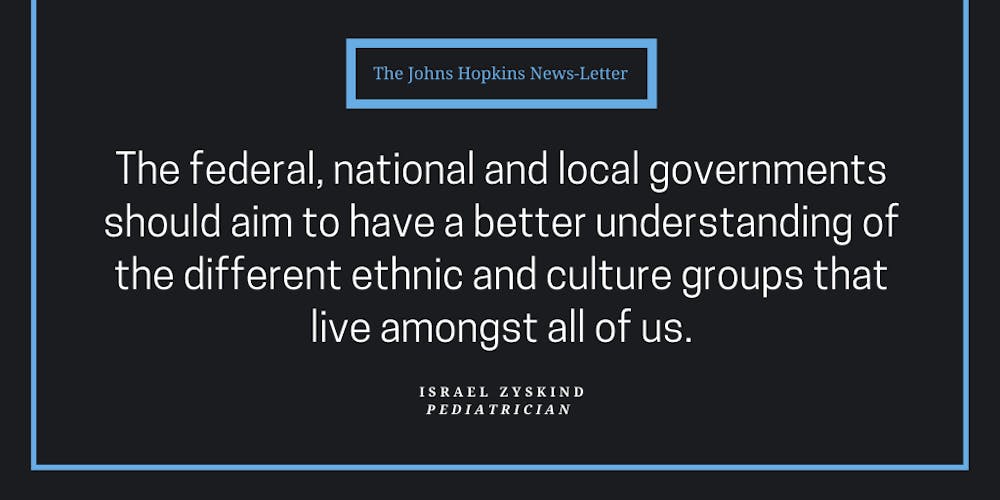In April 2020, Dr. Israel Zyskind spent his Passover in the car. Although driving during the holiday is typically not permitted, lives were at risk. A private-practice pediatrician affiliated with New York University and based out of New York, Zyskind spent the day visiting 10 to 20 COVID-19-positive households in his community, conducting wellness checks to see if individuals needed to be hospitalized. It certainly was a holiday like no other.
Dr. Avi Rosenberg, a pathologist at Hopkins and a college friend of Zyskind, also spent his Passover untraditionally. He spent the day on the phone consulting intensive-care doctors from across the East Coast. The two individuals connected over a mutual understanding of the detrimental impact of COVID-19 on the Orthodox Jewish community.
In spring of 2020, the New York Times reported that Hasidic communities experienced some of the first spikes of cases while the city braced for its first wave.
“I am in the Orthodox community. We were stricken by COVID early on,” Rosenberg said in an interview with The News-Letter.
After reconnecting, both physicians agreed that they could assemble a group to help their community better understand how to protect themselves. Eventually, they both worked on the formation of the Multi-institutional Study Analyzing Anti-CoV-2 Antibodies cohort, or the MITZVA (Hebrew for “commandment” or “good deed”) cohort.
The cohort performed a cross-sectional study of 9,500 Orthodox Jews across 12 states. In the massive study (published in the Journal of the American Medical Association this month), participants were asked to self-report symptoms related to COVID-19.
After this, participants submitted a blood sample for an antibody test. Most individuals who tested positive on the antibody test reported symptom onset between March 9 and March 31, 2020. This suggests that the Jewish holiday of Purim, celebrated March 9 to 10, could have been an event of common exposure for communities across the country.
According to the New York Times, Purim took place early enough in March that synagogues’ responses or COVID-19 accommodations were still fragmented across the city. While some synagogues did opt for virtual services, others continued in person. However, by Passover the next month, Rosenberg claims that he does not know of a single in-person gathering that occurred without massive mitigation strategies.
Zyskind posited that such a phenomenon of cases spiking after a cultural holiday could be the case for other culturally-bonded groups, citing microclusters and high seroprevalence rates in other New York communities.
“The global lesson from our paper is that even though we live in the United States of America, and we seem to be one big country and one United States, there are many cultures and microclusters that make us up,” Zyskind said in an interview with The News-Letter. “We all have our own unique social gatherings, our own holidays, our own assemblies and festivals.”
Purim was the holiday these investigators studied, but other cultural holidays could also be potential exposure events as well: Halloween, Chinese New Year or Easter, for example.
“The federal, national and local governments should aim to have a better understanding of the different ethnic and culture groups that live amongst all of us and customize and tailor the guidance or time it based on when each culturally, ethnically distinct group is most at risk,” Zyskind said.
With the spring holidays of Passover, Easter and Ramadan approaching, Rosenberg offered advice to people celebrating from his own perspective.
“You have to know who you’re celebrating with. When we handle kosher laws, we don’t eat food prepared at somebody’s house if we don’t know if they follow the same kosher standards that we follow. Similarly, in the COVID era, if you’re celebrating with people who don’t follow the same COVID standards that you follow, it might not be the best time to spend time with them,” he said.
Although last year these spring holidays very rarely occurred in person, he suggested that this year may look different as more people become vaccinated. Each small religious community is making its own hyper-specific guidance, sometimes to the point of accommodating specific individuals within a synagogue.
Besides these immediate findings, the study also generated large samples of sera that could be used for other research projects. Currently, these samples are under investigation in labs from Harvard University to Duke University.
In early March, a preprint used sera samples to identify IFNL13 antibodies in those affected by severe COVID-19. Rosenberg described the feeling that one mitzvah was leading to another with this work.
“It’s been honestly humbling and overwhelming,” he said. “We suffered as a community, we took the bull by the horns, we identified the source of the spread and then we responded as a community.”

















